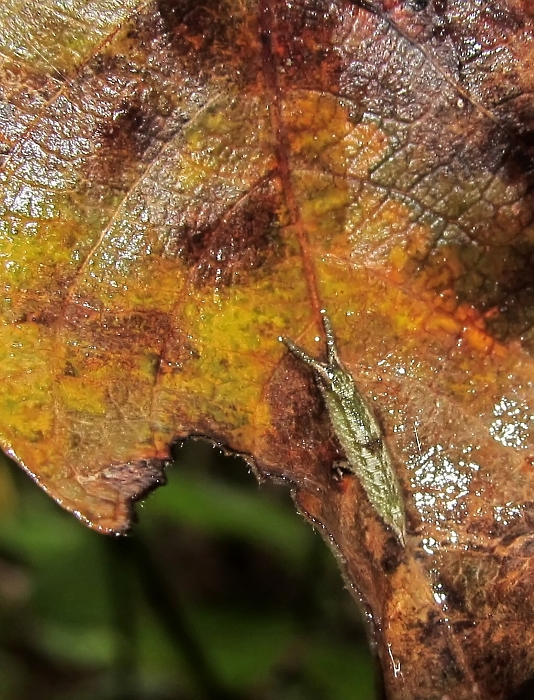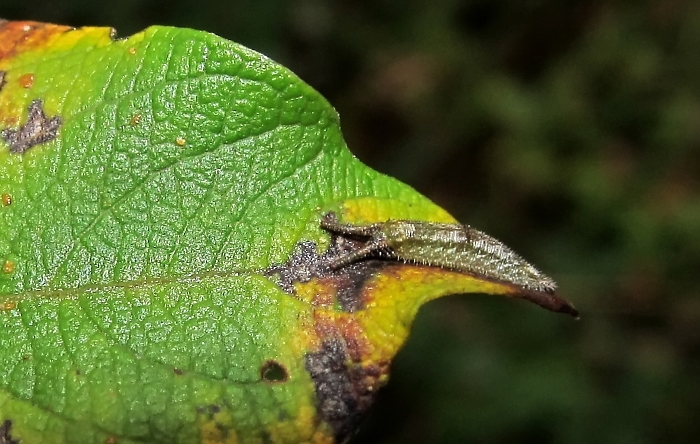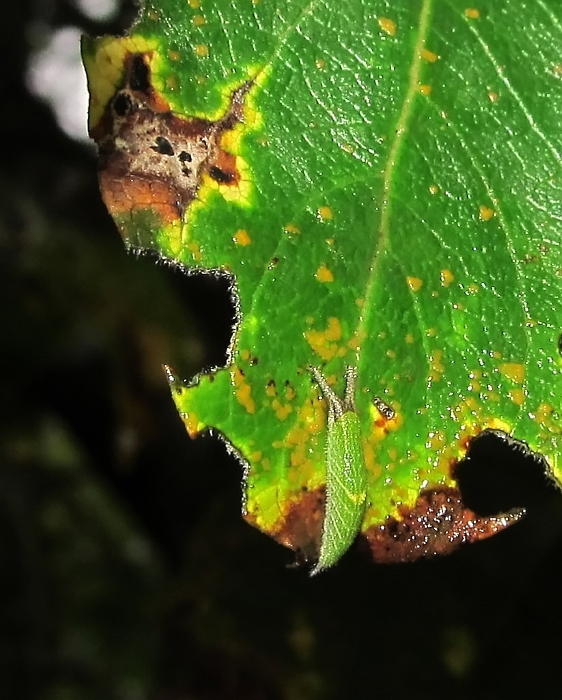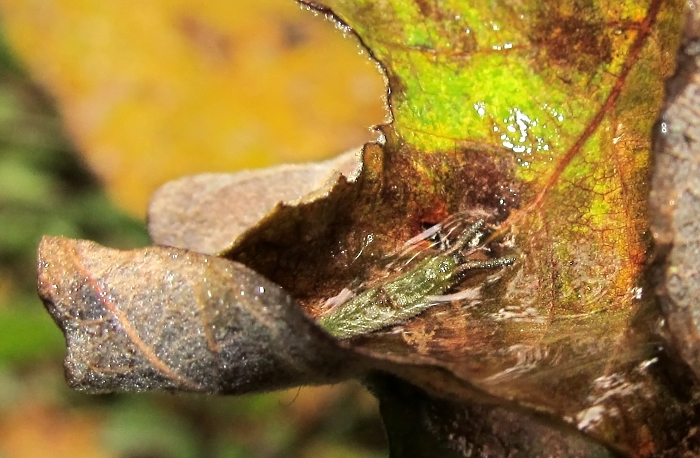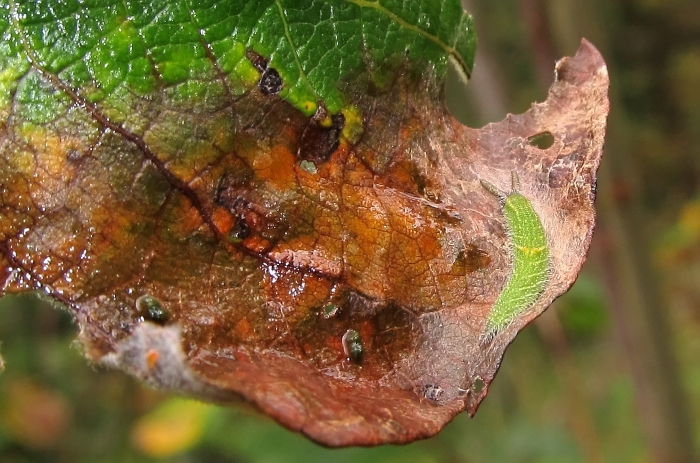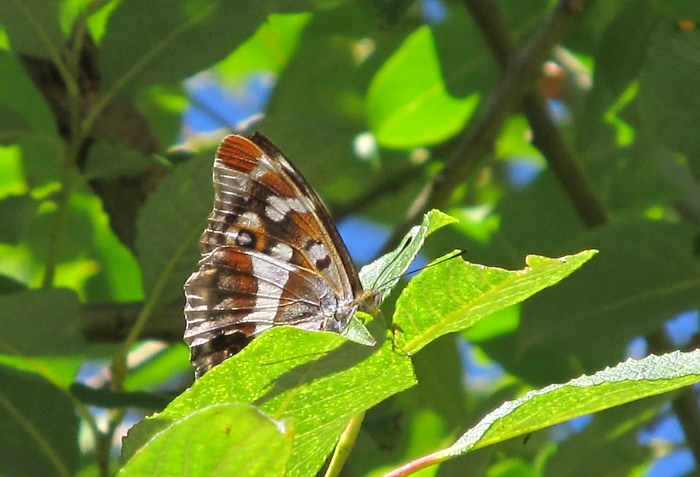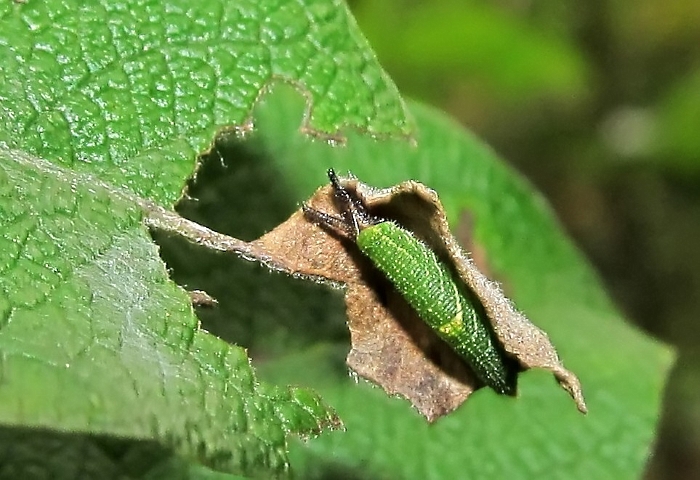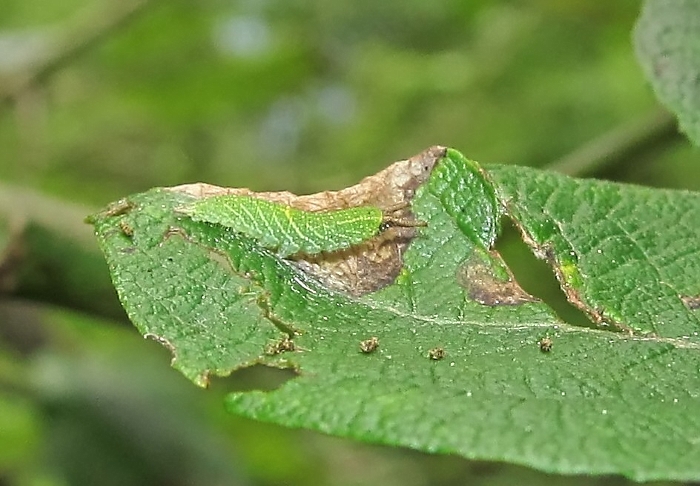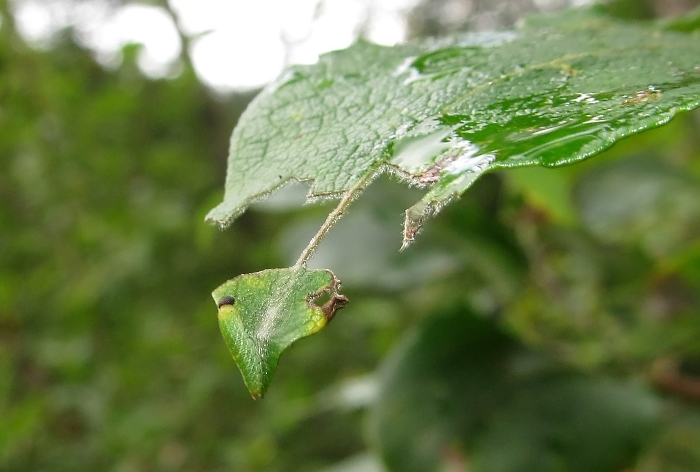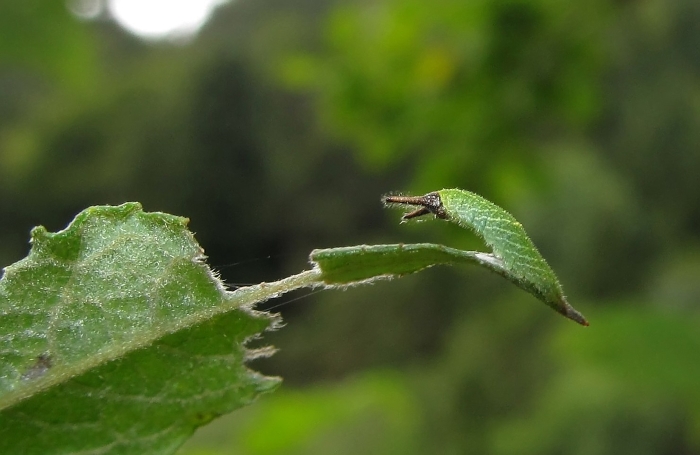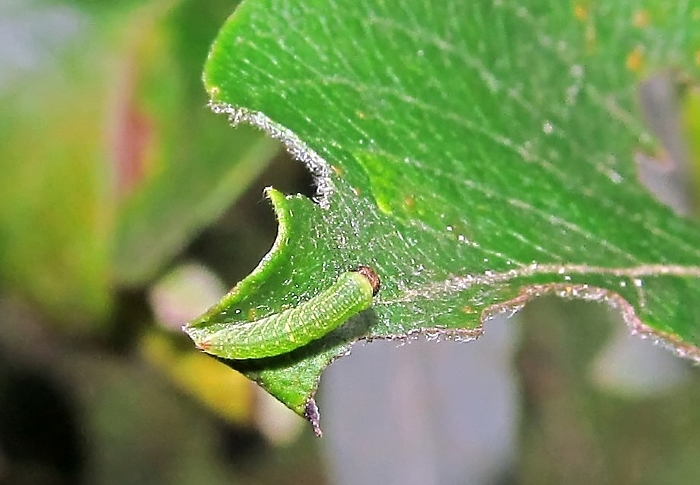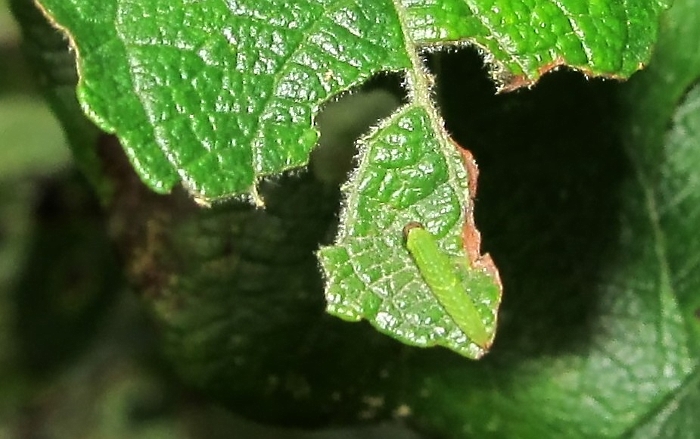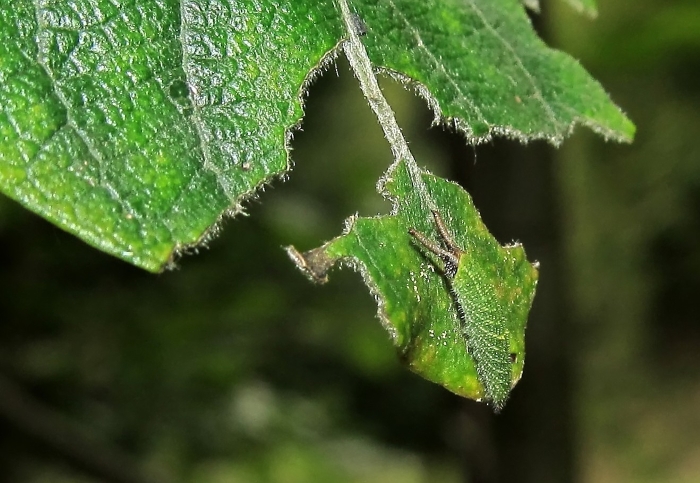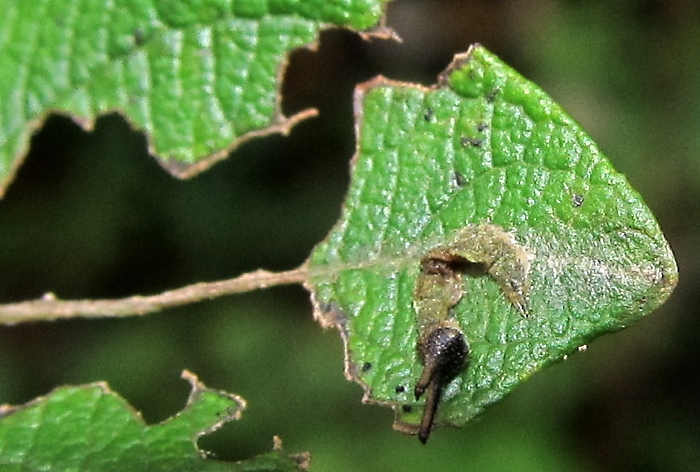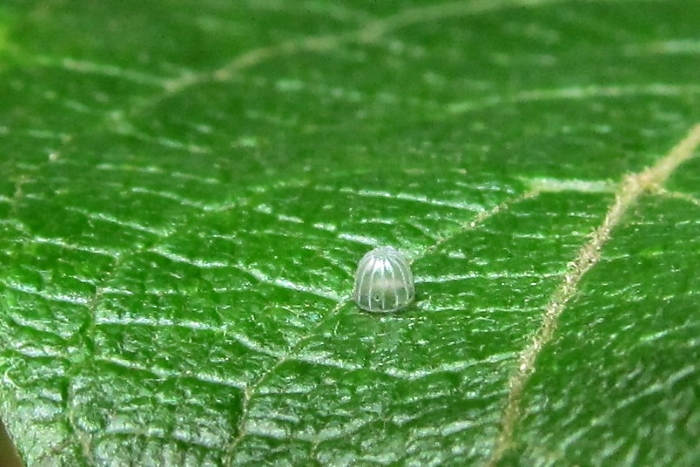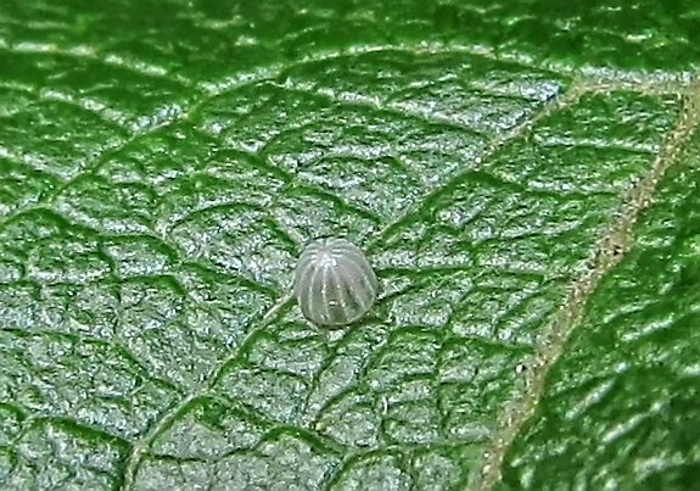Wednesday, December 31, 2014
Happy New Year!
Just watched the repeat of 'Obsession' on BBC iPlayer at
http://www.bbc.co.uk/iplayer/episode/b00wwbm4/natural-world-20102011-8-butterflies-a-very-british-obsession
Happy memories. Hoping for many more in 2015. Good luck everyone!
Tuesday, December 30, 2014
Friday, December 19, 2014
Seasoned Greetings!
Greetings to all followers of The Purple Empire
'First we sleep the winter, whilst we dream the spring'
Sunday, December 7, 2014
Early Christmas Present!
Delighted to have spotted these two leaves dangling in the breeze on strands of caterpillar silk, outside Savernake Forest -
The person responsible for the silk strands is just visible on the twig in the background. Here's a close up -
This is a remarkable find as larvae have been incredibly scarce this autumn.
Moreover, they are being predated, already. We urgently need a seriously cold winter - to protect hibernating larvae with frost and snow, and drive the tit flocks out of the forest on to bird tables in Marlborough and Burbage...
The person responsible for the silk strands is just visible on the twig in the background. Here's a close up -
This is a remarkable find as larvae have been incredibly scarce this autumn.
Moreover, they are being predated, already. We urgently need a seriously cold winter - to protect hibernating larvae with frost and snow, and drive the tit flocks out of the forest on to bird tables in Marlborough and Burbage...
Saturday, December 6, 2014
Monday, December 1, 2014
EASTERN REGION REPORT FOR 2014
For those that might be interested, our Eastern Region Report for 2014 is now available to read
http://www.dispar.org/reference.php?id=91
Tuesday, November 25, 2014
Y-Tube Olfactometer
Construction of the previously mentioned butterfly Y-Tube Olfactometer is thankfully now complete.
As you will see, I've even got the pastes ready in preparation for positive control testing. All we now need are the specimens. I will be digging out some Aglais urticae from local sheds and garages for testing of the equipment over the winter months, but apart from this, roll on the 2015 A.iris/A.ilia flight season. Where are all the male images just when you need them? I really can't wait to start playing around with this, hopefully we'll get some excellent data. More on this as the results unfold.
Mark
As you will see, I've even got the pastes ready in preparation for positive control testing. All we now need are the specimens. I will be digging out some Aglais urticae from local sheds and garages for testing of the equipment over the winter months, but apart from this, roll on the 2015 A.iris/A.ilia flight season. Where are all the male images just when you need them? I really can't wait to start playing around with this, hopefully we'll get some excellent data. More on this as the results unfold.
Mark
Sunday, November 23, 2014
Bookham Territory Videos
Essential Viewing: Three video pieces of male activity at the Hill Farm territory at Bookham Common, Surrey, filmed this season by Philip Wright. Certificate X (Over 18 only) -
https://www.youtube.com/watch?v=Z_fIgSiZ7J4&feature=youtu.be
https://www.youtube.com/watch?v=H7GwFLi3d1g&feature=youtu.be
https://www.youtube.com/watch?v=exhazHZ1Ivw
May contain scenes of gratuitous violence...
Enjoy....
Thank You Philip!
https://www.youtube.com/watch?v=Z_fIgSiZ7J4&feature=youtu.be
https://www.youtube.com/watch?v=H7GwFLi3d1g&feature=youtu.be
https://www.youtube.com/watch?v=exhazHZ1Ivw
May contain scenes of gratuitous violence...
Enjoy....
Thank You Philip!
Tuesday, November 18, 2014
Compound "X" (SPME-Headspace Analysis of The 'Medicine Mix')
Following on from an earlier post back in August of 2012, much work in this area has continued 'behind the scenes'. The conclusion from this investigative work lead me to believe that a specific (predicted) volatile was expected to be present in Matthew and Neil's magic 'Medicine Mix'. Please see their post on the subject matter, dated 21st August 2014. Today GC-MS SPME-headspace (Solid-Phase MicroExtraction) analysis was performed on a sample of their mix (although prepared by myself, according to their video instructions) and to my surprise I discovered that the predicted volatile was not only present, but also turned out to be the major volatile component (at least within the specific temperature range tested).
The volatile of interest is a major constituent of decomposing carcasses, is emitted from dog (and other predominantly but not exclusively carnivore) faeces, is a considerable component of the volatiles emitted from Limburger cheese [see Friedrich, 1977] and under certain conditions is also often present in human sweat secretions. The compound in question has been identified in the bouquet of fly pollinated plants and as such has been demonstrated to be a major attractant to these other insect species. If this wasn't enough however the volatile in question is also known to be present in the honeydew secreted by Quercus (Oak) aphids. I am currently in the process of constructing a laboratory grade, butterfly sized, Y-tube olfactometer in order to specifically test this and other volatile compounds on A.iris and A.ilia specimens. Assuming that the results obtained from these latter experiments are encouraging, you can expect to find me at Fermyn Woods next season (2015) with a ton of this compound in order to test if it works as an attractant literally out 'in the field'.
What then is this mysterious compound "X"? Sorry, but this you will need to wait until after further confirmation has been obtained in order to find out! More on this is obviously to follow...
Mark
Sunday, November 16, 2014
Silked on!
The last Emperor of the year - a pupal case left over from this flight season.
The leaf is superbly silked on -
It will be interesting to see how long the attachment lasts...
Sunday, November 9, 2014
Late Into Hibernation
Larvae are going into hibernation rather late this autumn, as happened last year when most larvae stayed on leaves until the third week of November.
Both in the wild and in captivity half the larvae are still on leaves. Here's one in hibernation in Savernake today, 1m from where it had been feeding (this one may move again...) -
And here's another from today, who is still on a green leaf (on a late leaf-fall tree) and is only about half coloured-up -
Both in the wild and in captivity half the larvae are still on leaves. Here's one in hibernation in Savernake today, 1m from where it had been feeding (this one may move again...) -
And here's another from today, who is still on a green leaf (on a late leaf-fall tree) and is only about half coloured-up -
The latest I've recorded a larva still on a leaf in the wild is Nov 24th...
Sunday, November 2, 2014
The Ultimate Badge
No money in the world can purchase this badge. The entire stock is in my possession, as I commissioned it from Paul Fosterjohn, Master Designer of Butterfly Badges.
The badges will be awarded to people who have seen acute aberrations of Apatura iris - when the criteria and, more importantly, rules for display and code of conduct have been determined by the Fellowship Committee.
Certainly, weak specimens of ab. semi-iole / iolata are excluded, some proof of encounter may be necessary, and wearers will be obliged to wear them on the anniversary of their encounter with this the Ultimate Butterfly. But there will be other specifications and stipulations...
Watch this space...
PS For Valour refers to the Emperor's valour, not ours...
Sunday, October 26, 2014
Going into Hibernation
Three of the 9 larvae I'm following have gone off their leaves to hibernate. One may have been predated, as I searched hard but I couldn't find him - but I'll check again when the leaves are off. Quite a few vanish without trace whilst crawling off to hibernate - I suspect that most are picked off by birds. Hibernating larvae are hard to find until all the leaves are off.
Most of those that are still on their leaves have coloured up nicely, but some have only just begun to change, including Percy, above.
Monday, October 20, 2014
And so to bed ...
6 of my 9 cats have left their leaves in the last couple of days and presumably settled down somewhere. So far, I have relocated two, Durgā and Trijaṭā:
It will become easier to look for the rest as the leaves fall.
Guy
Thursday, October 16, 2014
Purple Empire Exclusive
The Purple Empire Caterpillar pin badge bearing Matthew Oates's thought provoking motto goes on general sale on Tuesday the 21st of October. By then, all those who helped fund its production will have received their badges.
Only 10 remain of the reduced edition size of 40 pin badges. The price is £6.00 each and £1.20 p&p. For more information on how to purchase one please email me: britannicuspinbadges@gmail.com
For international orders please contact me for a shipping quote.
Monday, October 13, 2014
More colouring up
To follow Matthew's observations on colouring up, I can report that the larvae I am following here in Switzerland are a little ahead. Of nine iris cats on my daily dog-walk, 8 are coloured up and just one still green. Here are three in winter livery and the remaining summer cat, all photographed today:
(Brahmā)
(Śiva)
(Trijaṭā)
(Sarasvatī)
Guy
Sunday, October 12, 2014
Colouring Up
Larvae are just beginning to colour up in the wild - one out of 8 seen today had started to change colour, the others were still in Lincoln green. This is slightly behind the norm, but the weather has been mild.
There's a lot of rust, mildew, spots and assorted poxes on tree leaves this autumn, presumably because of the warm, moist summer. On sallows, there's a lot of blackening on leaf tips and edges, which is displacing larvae off their favoured tips.
Here's one of today's larvae -
Seemingly, throughout the Empire many sallows have blackened off badly, shedding leaves prematurely.
There's a lot of rust, mildew, spots and assorted poxes on tree leaves this autumn, presumably because of the warm, moist summer. On sallows, there's a lot of blackening on leaf tips and edges, which is displacing larvae off their favoured tips.
Here's one of today's larvae -
Seemingly, throughout the Empire many sallows have blackened off badly, shedding leaves prematurely.
Saturday, October 11, 2014
Tuesday, October 7, 2014
Autumn colours
Here in Switzerland autumn is falling early and some of my iris cats are beginning to turn too. I'm still seeing the same 9 on my daily dog-walk - here are four of them, in different shades of green, today:
(Sarasvatī)
(Brahmā)
(Varuṇa)
(Durgā)
Guy
Sunday, October 5, 2014
Final Savernake Tally
The tally for my annual standardised count of iris larvae in / around Savernake Forest is a measly 20, the lowest total in six years of diligent recording. Last year it was over 200!
Worryingly, I've found a lot of failed breeding sites, where 1st or 2nd instar larvae had been feeding. Most of these have been checked twice, just in case of oversight. It looks as though the incidence of 1st and / or 2nd instar fatality has been unusually high this year. This may be because of the cold, wet August, though I suspect it may be due to the leaves being too thick and coarse following an early and rapid spring.
Here's a trio of leaves bearing seat pads and feeding marks of lost young larvae (+ egg case bases) -
Note the leaf tip damage.
I rarely find any on narrow-leaved sallows in / around Savernake. Here's an exception - and a rare example of a larva not on a leaf tip -
Worryingly, I've found a lot of failed breeding sites, where 1st or 2nd instar larvae had been feeding. Most of these have been checked twice, just in case of oversight. It looks as though the incidence of 1st and / or 2nd instar fatality has been unusually high this year. This may be because of the cold, wet August, though I suspect it may be due to the leaves being too thick and coarse following an early and rapid spring.
Here's a trio of leaves bearing seat pads and feeding marks of lost young larvae (+ egg case bases) -
Note the leaf tip damage.
I rarely find any on narrow-leaved sallows in / around Savernake. Here's an exception - and a rare example of a larva not on a leaf tip -
Sunday, September 28, 2014
Female Mating Acceptance Posture!

Many more experiments await. However, for references of acceptance postures please refer to the following links: Langlois (1964), Nishida (1996), Wantanabe (2011). The links can be found below:
https://kb.osu.edu/dspace/bitstream/handle/1811/4971/1/V64N01_001.pdf
http://link.springer.com/article/10.1007/BF02029947#page-1
http://images.peabody.yale.edu/lepsoc/jls/2010s/2011/2011-65-4-259.pdf
Thursday, September 25, 2014
A Paean for Chattenden
Those of you who know your butterflying history will be instantly roused by the name of Chattenden, for Great Chattenden Wood (to give it its full name) was the premier collecting venue for London collectors during the mid to late Victorian era. In particular, it was the most cherished collecting ground for the Purple Emperor, producing a vast number of specimens and some acute aberrations -
Taken ca 1870, and -
Taken in July 1878, and described as ab. chattendeni by Heslop; and -
The frontispiece for Frohawk's Variations, taken in 1866.
Chattenden was the Fermyn of its day.
There are some amazing descriptions of Emperoring at Chattenden, in Frohawk and Tutt. These are quoted in Heslop (1964). Tutt (1896) states, 'In the 'seventies' A. iris was the insect of Chattenden Woods'. He continues that males and females: 'had a custom of flying for a few hours (11am to 3pm) to the highest point of the wood, and soaring around a few oaks that topped the hill. Here they settled and became easy prey. With a large ring net on the end of a long hop-pole about twelve or fourteen feet in length ... we have seen as many as nine amateur collectors standing in a line at three or four yards distance, and netting every specimen as it came up ... in one year (1881) alone, some two or three hundred specimens were captured. Such are the depths to which entomology has been reduced. Needless to say, the insect is now practically extinct in these woods.'
Frowhawk (1924) writes: 'In Chattenden Woods, Kent, where these butterflies formerly occurred abundantly, the females were in the habit of resorting to the highest ground, the brow of a large hill, on the summit of which were a few oak trees; these were the favourite resort of this species, and large numbers were captured yearly.' He continues: 'the author has seen freshly emerged specimens pairing on the oaks on the hill' and laments, 'ninety-seven of these butterflies were captured in a few days by two men - a dealer and his friend.'
Frohawk reckons that iris had disappeared from Chattenden by the end of the 'eighties'. However, Heslop states that the War Department (MOD), which took over - and cleared - much of the site during WW1, used to issue permits for the collecting of Purple Emperors 'into the twenties of the present century', and also mentions that the butterfly was successfully reintroduced there.
The MOD land became known as Lodge Hill. This area - the eastern part of Great Chattenden Wood - is the proposed site of 5,000 new homes, despite it having been designated as an SSSI owing to the presence of a large population of Nightingales. Interestingly, His Grace the Duke of Burgundy has recently been discovered there.
I toured Chattenden during the winter of 1976-77 and more recently one dull November day, and felt on both occasions that the site was still suitable for iris. Lodge Hill is now, apparently, thick with sallows. Best of all, the butterfly was seen nearby this year.
Gentlemen, iris is back in Chattenden, though I suspect he may never have left - and a major public inquiry must loam. Frohawk and Tutt's hill is presumably the prominent hillock at the western end of the surviving wood, above Cliffe - it had that feel about it when I visited.
Taken ca 1870, and -
Taken in July 1878, and described as ab. chattendeni by Heslop; and -
The frontispiece for Frohawk's Variations, taken in 1866.
Chattenden was the Fermyn of its day.
There are some amazing descriptions of Emperoring at Chattenden, in Frohawk and Tutt. These are quoted in Heslop (1964). Tutt (1896) states, 'In the 'seventies' A. iris was the insect of Chattenden Woods'. He continues that males and females: 'had a custom of flying for a few hours (11am to 3pm) to the highest point of the wood, and soaring around a few oaks that topped the hill. Here they settled and became easy prey. With a large ring net on the end of a long hop-pole about twelve or fourteen feet in length ... we have seen as many as nine amateur collectors standing in a line at three or four yards distance, and netting every specimen as it came up ... in one year (1881) alone, some two or three hundred specimens were captured. Such are the depths to which entomology has been reduced. Needless to say, the insect is now practically extinct in these woods.'
Frowhawk (1924) writes: 'In Chattenden Woods, Kent, where these butterflies formerly occurred abundantly, the females were in the habit of resorting to the highest ground, the brow of a large hill, on the summit of which were a few oak trees; these were the favourite resort of this species, and large numbers were captured yearly.' He continues: 'the author has seen freshly emerged specimens pairing on the oaks on the hill' and laments, 'ninety-seven of these butterflies were captured in a few days by two men - a dealer and his friend.'
Frohawk reckons that iris had disappeared from Chattenden by the end of the 'eighties'. However, Heslop states that the War Department (MOD), which took over - and cleared - much of the site during WW1, used to issue permits for the collecting of Purple Emperors 'into the twenties of the present century', and also mentions that the butterfly was successfully reintroduced there.
The MOD land became known as Lodge Hill. This area - the eastern part of Great Chattenden Wood - is the proposed site of 5,000 new homes, despite it having been designated as an SSSI owing to the presence of a large population of Nightingales. Interestingly, His Grace the Duke of Burgundy has recently been discovered there.
I toured Chattenden during the winter of 1976-77 and more recently one dull November day, and felt on both occasions that the site was still suitable for iris. Lodge Hill is now, apparently, thick with sallows. Best of all, the butterfly was seen nearby this year.
Gentlemen, iris is back in Chattenden, though I suspect he may never have left - and a major public inquiry must loam. Frohawk and Tutt's hill is presumably the prominent hillock at the western end of the surviving wood, above Cliffe - it had that feel about it when I visited.
Wednesday, September 24, 2014
Purple Emperor Polo Shirts
Just spotted this on the BC website http://butterfly-conservation.myshopify.com/collections/clothing/products/purple-emperor-polo-shirt
- already on my Christmas list - must have uniform methinks.
Kind regards
Mark
- already on my Christmas list - must have uniform methinks.
Kind regards
Mark
Monday, September 22, 2014
More Depressing News...
Two-thirds of the way through my annual survey of iris breeding sites in / around Savernake Forest and it looks very much as though this year will prove to be the poorest in six years of systematic recording.
To date only 16 breeding sites have been found - that's both live larvae and failed breeding sites (i.e. definite vacant larval seat pads + egg case bases, and no sign of the larvae anywhere).
Worse, only five live larvae have been found - along with 11 failed breeding sites. That is an unusually and worryingly high proportion of failed larvae, usually it's the other way round. I will look around the failed sites again, as one or two larvae may yet be located - they can wander quite far, especially just after the second skin change (yesterday I found a third instar larva 2.5m away from the egg case base and 1st / 2nd instar feeding leaf, but they can travel much further).
Perhaps the cold, wet August (memorable for ex-Hurricane Bertha sitting over us for a week mid-month) caused high mortality. However, I strongly suspect that the bulk of these disappearances result from mortality due to unsuitable foliage: early springs produce leaves that are too thick, coarse (dark-leaved to our eyes) for young larvae in late summer. Certainly, there is a shortage of the favoured 'mid-green soft matt leaves of medium thickness' around this early autumn.
Of course, all this is based on the assumption that the females consistently lay low down from year to year. They may, or they may not... the minxes...
Finally, a plea to support Paul Fosterjohn's production of a badge showing a Purple Emperor larva and the Never Underestimate a Caterpillar motto (in English and Latin). Paul needs more subscribers. Details -
This is a crowd-funding initiative in that I need 40 orders placed within a month before I go into production. I am looking for each person to order at least one pin badge and send me a cheque for the amount of £5.50 per badge with an additional £1.20 for postage (for up to four badges). I will bank all the cheques on the 4th of October ONLY IF 40 orders have been received.
email britannicuspinbadges@gmail.com
I particularly want this badge...
To date only 16 breeding sites have been found - that's both live larvae and failed breeding sites (i.e. definite vacant larval seat pads + egg case bases, and no sign of the larvae anywhere).
Worse, only five live larvae have been found - along with 11 failed breeding sites. That is an unusually and worryingly high proportion of failed larvae, usually it's the other way round. I will look around the failed sites again, as one or two larvae may yet be located - they can wander quite far, especially just after the second skin change (yesterday I found a third instar larva 2.5m away from the egg case base and 1st / 2nd instar feeding leaf, but they can travel much further).
Perhaps the cold, wet August (memorable for ex-Hurricane Bertha sitting over us for a week mid-month) caused high mortality. However, I strongly suspect that the bulk of these disappearances result from mortality due to unsuitable foliage: early springs produce leaves that are too thick, coarse (dark-leaved to our eyes) for young larvae in late summer. Certainly, there is a shortage of the favoured 'mid-green soft matt leaves of medium thickness' around this early autumn.
Of course, all this is based on the assumption that the females consistently lay low down from year to year. They may, or they may not... the minxes...
Finally, a plea to support Paul Fosterjohn's production of a badge showing a Purple Emperor larva and the Never Underestimate a Caterpillar motto (in English and Latin). Paul needs more subscribers. Details -
This is a crowd-funding initiative in that I need 40 orders placed within a month before I go into production. I am looking for each person to order at least one pin badge and send me a cheque for the amount of £5.50 per badge with an additional £1.20 for postage (for up to four badges). I will bank all the cheques on the 4th of October ONLY IF 40 orders have been received.
email britannicuspinbadges@gmail.com
I particularly want this badge...
Sunday, September 14, 2014
The Nightmare Continues...
I am about half way through my annual search for Purple Emperor larvae in / around Savernake Forest, Wilts. This is the 6th year I've done this. To date I have found only 12, and it looks as though this will be the poorest year I've recorded.
Part of the problem is the shortage of suitable mid-green, soft, matt foliage. Far too much of the foliage this season is thick and coarse leaved, which is dark-green or even blue-green in colour. This results from the early and rapid spring we had. It seems that late springs produce more suitable foliage for the late summer / autumn larvae.
I've found an unusually high number of failed breeding sites this season, where the larvae have vanished. This I attribute primarily to the preponderance of coarse, thick leaves, though the cold, wet August cannot have helped.
Another problem is extensive damage on previously favoured trees by frog hopper nymphs. They've trashed many of the best breeding trees, curse and crush them.
However, here's a healthy larva I found today, changing from 2nd to 3rd instar (a little on the late side) -
Part of the problem is the shortage of suitable mid-green, soft, matt foliage. Far too much of the foliage this season is thick and coarse leaved, which is dark-green or even blue-green in colour. This results from the early and rapid spring we had. It seems that late springs produce more suitable foliage for the late summer / autumn larvae.
I've found an unusually high number of failed breeding sites this season, where the larvae have vanished. This I attribute primarily to the preponderance of coarse, thick leaves, though the cold, wet August cannot have helped.
Another problem is extensive damage on previously favoured trees by frog hopper nymphs. They've trashed many of the best breeding trees, curse and crush them.
However, here's a healthy larva I found today, changing from 2nd to 3rd instar (a little on the late side) -
Saturday, September 13, 2014
Twilight of the Empire
In a disused quarry in the Swiss Rhône Valley, a lone emperor was defying the precocious autumn this morning, watching the world go by from a sallow tree:
I think this is a male. I spotted it in flight and initially took it for a female - no visible hint of gleaming blue during the brief time it twisted and glided in front of me - but from its general appearance and the way it then sat high in the sallow for the next hour, I changed my mind to male. Some shots taken when it opened its wings showed a very, very slight note of purple:
According to MétéoSuisse - and matching my own observations - this autumn is falling a couple of weeks earlier than average, measured by phenological indicators like hazel catkins. His Imperial Majesty truly is a law unto Himself!
Will this be the last record from the Empire this year?
Guy
Wednesday, September 3, 2014
Purple Empire Exclusive
Ladies and Gentlemen, earlier in the season I mooted the idea of a golden caterpillar award but unfortunately had to shelve plans. However, I kept the design to one side as it deserves to go into production.
Therefore, the time is right and offered for pre-order only to people of purple persuasion via the Purple Empire blog.
The design depicts Keats ascending in raised metal from the surface which is slightly recessed. All this surrounded by Matthew Oates' well known Latin phrase with English translation on a background of regal blue enamel. The size of the badge will be 30mm wide by 25mm tall. Please note that spelling has been corrected as per the comments.
The pin badges will be limited to 40 pieces only cost of £5.50 each. Postage and packing will be an additional £1.20.
To take part in the pre-order offer and reserve a badge or badges (yes, you can order more than one if you wish) you should send me an email with PURPLE EMPIRE in the subject title to britannicuspinbadges@gmail.com and I will send you details of what you need to do next.
Therefore, the time is right and offered for pre-order only to people of purple persuasion via the Purple Empire blog.
The design depicts Keats ascending in raised metal from the surface which is slightly recessed. All this surrounded by Matthew Oates' well known Latin phrase with English translation on a background of regal blue enamel. The size of the badge will be 30mm wide by 25mm tall. Please note that spelling has been corrected as per the comments.
The pin badges will be limited to 40 pieces only cost of £5.50 each. Postage and packing will be an additional £1.20.
To take part in the pre-order offer and reserve a badge or badges (yes, you can order more than one if you wish) you should send me an email with PURPLE EMPIRE in the subject title to britannicuspinbadges@gmail.com and I will send you details of what you need to do next.
Sunday, August 31, 2014
Woe, and thrice Woe!
My first full search for larvae in / around Savernake took place yesterday, accompanied by Ian Shale. In 4hrs 30 mins searching we found signs of three larvae, only - egg case bases and 1st instar larval feeding leaves + silk seat pads, two of them with 2nd instar feeding leaves too. But no attendant larvae. Presumably, these had perished.
The tiny egg case bases can last for weeks - last year I found one in early November. But the larva eats the bulk of the egg, leaving just the glued-on base behind, like this:-
The larval feeding leaves + seat pads are quite salient by late August, hence why I prefer to look for 2nd or 3rd instar larvae, rather than eggs. They look like this:-
This is a dismal tally, given that we searched much of the traditional main breeding area. Last year the same trees produced nearly 50 larvae! Part of the problem was that frog-hopper nymphs had devastated much of the foliage, and iris females avoid such trees. Also, the early spring had led to the development of coarse, thick and dark leaves, which are generally avoided. I realise why I saw just a lone female in that part of the forest this flight season.
The hunt is now on to find where the females laid their eggs...
Watch this space, but at present the prospects for 2015 look distinctly bleak!
The tiny egg case bases can last for weeks - last year I found one in early November. But the larva eats the bulk of the egg, leaving just the glued-on base behind, like this:-
The larval feeding leaves + seat pads are quite salient by late August, hence why I prefer to look for 2nd or 3rd instar larvae, rather than eggs. They look like this:-
This is a dismal tally, given that we searched much of the traditional main breeding area. Last year the same trees produced nearly 50 larvae! Part of the problem was that frog-hopper nymphs had devastated much of the foliage, and iris females avoid such trees. Also, the early spring had led to the development of coarse, thick and dark leaves, which are generally avoided. I realise why I saw just a lone female in that part of the forest this flight season.
The hunt is now on to find where the females laid their eggs...
Watch this space, but at present the prospects for 2015 look distinctly bleak!
Friday, August 29, 2014
Swiss Update
In answer to Dennis, below, it's difficult to give a useful comparison because I have only searched on readily accessible sallows, in places I can easily check on my daily dog-walk. Of 12 eggs originally found, the tally is: 10 hatched (the remaining two are dead), 3 cats gone awol, 1 cat known dead and 6 still in the pink of health (3 1st instar and 3 2nd instar, as of today). I subsequently found another second instar cat, so I am presently keeping tab on 7 cats in total. They are (as photographed this morning):
Brahmā:
Sarasvatī:
Varuṇa
Indra
Trijaṭā
Vibhīṣaṇa
Sītā
Brahmā:
Sarasvatī:
Varuṇa
Indra
Trijaṭā
Vibhīṣaṇa
Sītā
Poor old Rāma was eaten by something a couple of days ago - so he's the one I know is dead:
The egg that I found eaten on August 10th is still intact on its leaf, nearly three weeks later:
(Aug 10th)
(today, 29th August)
Et voilà! It remains to be seen how many of these I will be able to follow into hibernation!
Guy
Thursday, August 28, 2014
larvae
It does not get better in Bucks/Oxon: so far, just 5 found in 7 hours intensive searching in five woods.
Guy: how is it in Switzerland?
It will be interesting to hear how Matthew gets on in Savernake.
Guy: how is it in Switzerland?
It will be interesting to hear how Matthew gets on in Savernake.
Purple Battles from 2014 season
Hi all, have put together a selection of shots of Emperors battling over this past 2014 summer season. All taken at the Bookham Common Hill Farm territory. Best wishes - Rob Hill
A selection of males sparring...
A male pursuing a female (the pair slowly moved around the territory canopy for over 15 minutes).
Male active in the canopy late in season
Male chasing a dragonfly.
Subscribe to:
Posts (Atom)
















